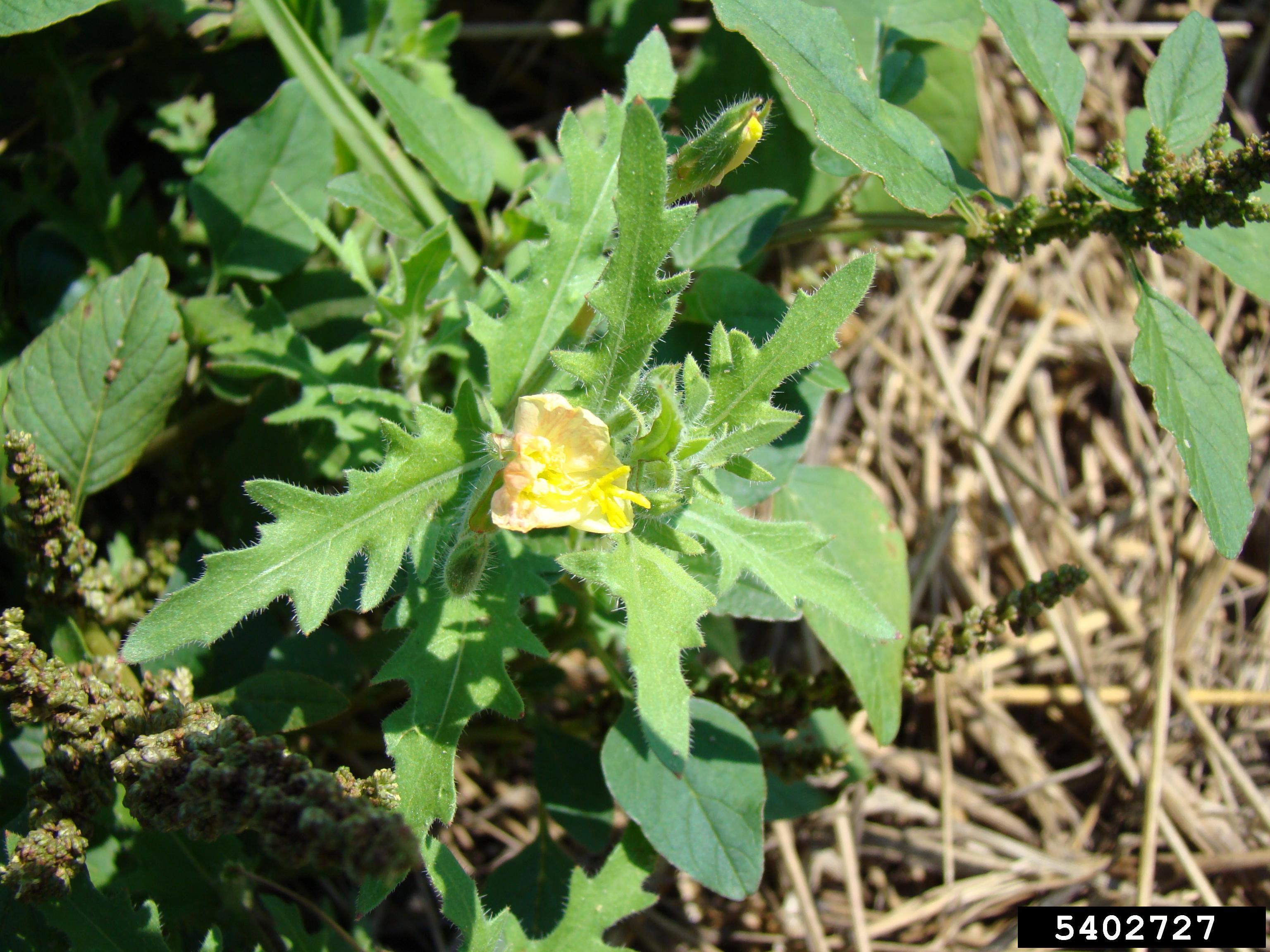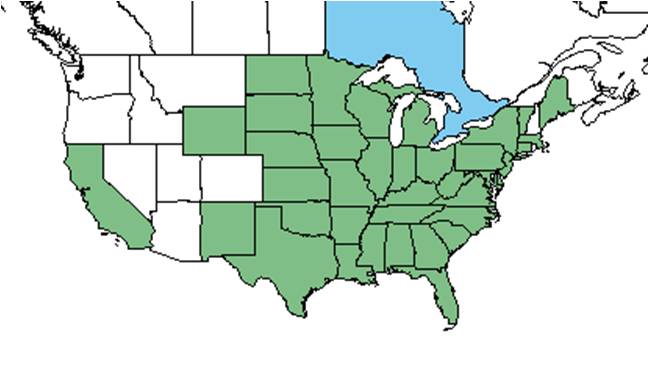Oenothera laciniata
| Oenothera laciniata | |
|---|---|

| |
| Photo by Rebekah D. Wallace, University of Georgia, Bugwood.org | |
| Scientific classification | |
| Kingdom: | Plantae |
| Division: | Magnoliophyta - Flowering plants |
| Class: | Magnoliopsida – Dicotyledons |
| Order: | Myrtales |
| Family: | Onagraceae |
| Genus: | Oenothera |
| Species: | O. laciniata |
| Binomial name | |
| Oenothera laciniata Hill | |

| |
| Natural range of Oenothera laciniata from USDA NRCS Plants Database. | |
Common name: cutleaf evening primrose
Contents
Description
"Usually pubescent, branched biennials or perennials. Leaves alternate, the upper reduced, sessile or subsessile, the lower frequently petiolate. Inflorescent terminal, flowers solitary from axils of bracts or reduced upper leaves. Calyx tube (hypanthium above ovary or capsule) prolonged; lobes (sepals) 4, acute. Petals 4, yellow, pink, or white, usually widely obcordate. Stamens 8, exserted; stigmas 4. Capsules oblong to obovoid or clavate; seeds numerous, not comose." - Radford et al 1964
"Pubescent biennial, usually with decumbent, basal braches, stems to 7.5 dm long. Leaves oblanceolate to elliptic, pubescent to glabrate, acute, irregularly lobed or pinnatifid, repand or almost entire, base attenuate; petioles absent or to 3 cm long on basal leaves. Calyx tube 2-2.5 cm long, lobes 6-12 mm long; petals yellow to reddish, 8-25 mm long; anthers 3-6 mm long. Capsules pubescent, cylindric, usually slightly arcuate, 2.5-4 cm long, 3-4 mm broad; pedicels absent or to 5 mm long; seeds brownish, angulate, 1.2-1.4 mm long, ca. 0.8 mm broad, pitted." - Radford et al 1964
Distribution
It is native to all of North America east of the Rocky Mountains, however, can be found in some areas west of the Rockies [1].
Ecology
Habitat
In the Coastal Plain in Florida and Georgia, O. laciniata occurs in shrub bogs, pine flatwoods, and pine savannas. It is observed to be a ruderal species and has been found in disturbed areas such as sandy vacant lots, moist roadsides, fallow fields, and railroad beds. Soil types include sandy loam, loam, and loamy sand. Associated species include Drosera, Calopogon, Briza, and Cerastium (FSU Herbarium). It is a common weed found in soybean, corn, and cotton crops in the southeastern U.S. (Webster 2004). It has become an invasive species in central and south America, Europe, Africa and Australia [2].
Phenology
It has been observed flowering January through May and fruiting January through June (FSU Herbarium). Flowers typically bloom at night [3].
Seed dispersal
Fruits are dehiscent [2].
Seed bank and germination
Seeds can remain viable in the soil for decades [4].
Fire ecology
It has been observed growing in annually burned pine savannas (FSU Herbarium).
Pollination
The following Hymenoptera families and species were observed visiting flowers of Oenothera laciniata at Archbold Biological Station (Deyrup 2015):
Vespidae: Polistes dorsalis hunteri
Use by animals
Seeds are eaten by bobwhite quail, morning doves, and American gold finches. Cottontail rabbits and white-tailed deer browse on the foliage[3].
Diseases and parasites
It is a host for clouded and tarnished plant bugs that are common pests of cotton [5].
Conservation and Management
It is a noxious weed in soybean, cotton, and corn crops in the southeastern U.S. (Webster 2004). In a reduced-tillage system it may be difficult to control when timely applications are not made (Fairbanks et al. 1995). This species' small size and slow growth make February and early March herbicide applications most effective (Clewis et al. 2007).
Cultivation and restoration
Historically, it was used by Cherokee Indians as a potherb and to make body wash [6].
Photo Gallery
References and notes
Deyrup, M.A. and N.D. 2015. Database of observations of Hymenoptera visitations to flowers of plants on Archbold Biological Station, Florida, USA.
Clewis, S. B., D. L. Jordan, et al. (2007). "Influence of Environmental Factors on Cutleaf Eveningprimrose (Oenothera laciniata) Germination, Emergence, Development, Vegetative Growth, and Control." Weed Science 55(3): 264-272.
Fairbanks, Douglans, E., D.B. Reynolds, J.I. Griffin, P.R. Vidrine, and D.I. Jordan. 1995. Preplant weed control with Gramoxone Extra and Roundup D-Pak mixed with Harmony Extra. Pages 90-93 in M.R. McClelland, T.D. Valco and R.E. Frans. Eds. Conservation-Tillage Systems for Cotton. Fayetteville, AR: Arkansas Agricultural Experiment Station Special Report. 160.
Florida State University Robert K. Godfrey Herbarium database. URL: http://herbarium.bio.fsu.edu. Last accessed: October 2015. Collectors: Miguel Altieri, Loran C. Anderson, Robert Blaisdell, K. Craddock Burks, Andre F. Clewell, George R. Cooley, A.H. Curtiss, Suellen Folensbee, Robert K. Godfrey, M. Knott, R. Komarek, Robert Kral, Richard S. Mitchell, Joseph Monachino, J.B. Nelson, Gwynn Ramsey, Cecil R. Slaughter, Bian Tan, L.B. Trott. States and Counties: Florida: Alachua, Columbia, Dixie, Duval, Franklin, Holmes, Jackson, Jefferson, Leon, Liberty, Madison, Okaloosa, Pasco, Pinellas, Polk, Putnam, Taylor, Wakulla. Georgia: Grady, Seminole. Compiled by Tall Timbers Research Station and Land Conservancy.
Guy, C.B. 1995. Preplant weed management in Arkansas no-till and stale seedbed cotton. Pages 86-89 in M.R. McClelland, T.D. Valco, and R.E. Frans. Edx. Conservation Tillage Systems for Cotton, Fayetteville, AR. Arkansas Agricultural Experiment Station Special Report. 160.
Radford, Albert E., Harry E. Ahles, and C. Ritchie Bell. Manual of the Vascular Flora of the Carolinas. 1964, 1968. The University of North Carolina Press. 750-2. Print.
Webster, Theodore M. 2004. Weed survey-southern states: broadleaf crops subsection. South. Weed Sci Soc. 58: 291-306
- ↑ [[1]] Lady Bird Johnson Wildflower Center Accessed: February 12, 2016
- ↑ 2.0 2.1 [[2]] Accessed February 10, 2016
- ↑ 3.0 3.1 [[3]] Illinois Wildflowers. Accessed: February 12, 2016
- ↑ [[4]] University of Tennessee Extension. Accessed: February 12, 2016
- ↑ [[5]] University of Tennessee Extension
- ↑ [[6]] University of Florida IFAS Extension Accessed: February 12, 2016